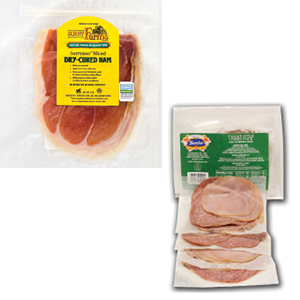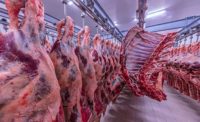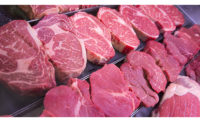
|
When meat is sliced paper thin and delicate in particular, as in the case of Surry, Va.-based S. Wallace Edwards & Sons Inc.’s dry-cured products, if the slices are not interleaved, they stick together, says Samuel Edwards III, president of the company.
“When it’s sliced that thin, people like the slices to remain intact, and interleaving the slices improves the performance of the finished product,” he says.
Portion control is another benefit to interleaving, says Gerald Lessard, chief operating officer for West Liberty Foods, West Liberty, Iowa. For example, if a foodservice operator is expecting an employee to count out the number of slices to put on a sandwich, one might occasionally miscount one way or the other.
Greater food safety can be another advantage to interleaving, he says.
“There’s less handling when the portion is on a piece of paper than when it’s done on an individual sliced basis,” Lessard explains. “I don’t have to pick up six slices. If six slices are already on a piece of paper, I pick up the piece of paper and put it on a sandwich.”
Dave Grazier, vice president of operations at Kunzler & Co. Inc.’s Tyrone, Pa., facility, agrees that interleaving makes the product more user-friendly.
“In the case of interleaved luncheon meat sets, the customer can easily pick up the exact portion that is needed for the sandwich that they are making without having to separate slices or weigh them out for themselves,” he says. “In layout bacon, the customer can actually cook the bacon on the interleaf paper or use it as a spatter guard on top of the grill.”
Ease of separation
Most of the interleaving Kunzler does is in producing pre-portioned interleaved luncheon meat sandwich setups.
“We make both single-meat and combination-meat set-ups for the foodservice sector, especially convenience-store sandwich operations,” Grazier says. “This is a growing opportunity in that our customers are looking for ways to make their operations more efficient. This also takes the guesswork out of how much meat to use on a sandwich. We also interleave layout bacon for foodservice-type applications.”
One of the greatest challenges to interleaving and stacking luncheon meat is keeping the weights consistent. For example, since Kunzler runs two or three lanes of lunch meat setups per slicer, it is a challenge to keep the weights consistent from one lane to another, especially on combo-meat setups where the company is running three or more varieties of meat into one portion.
S. Wallace Edwards & Sons currently is interleaving ham slices and sausage patties by hand, and layout bacon on oven paper automatically. Although interleavers now are capable of handling very thinly sliced products, the smaller-sized processor finds the cost of the machines prohibitive.
“Of course, as a small manufacturer, I’d like to see a less expensive one,” Edwards says. “It could be slower and less expensive.”
As far as the actual function of the interleavers and stackers are concerned, these machines have come a long way over the years and processors now experience very minimal problems in accomplishing this task.
“Our interleavers are very efficient and trouble-free,” Grazier says. “I can remember the early technology in interleaving resulted in more frequent breakdowns and paper jams. Now with the PC-controlled interleavers and stackers, we experience very little downtime on that end of the line.”
Lessard agrees that now processors have more finite control of the equipment.
“There are servo motors and PLC controls that we didn’t have available for us in the past,” he says. “The ease of operation, because of the PLC controls, allows more flexibility, and it’s easier for the operator to change paper lengths and those types of things.”
Interleavers today are much faster than previous models as well, a trend processors see continuing to improve in the future.
“I would also look for the stackers to become more automated in transferring the stacks of product into the packaging machines,” Grazier says. Lessard also sees the opportunity for interleave machines that could place a piece of paper in between individual proteins in a multi-protein setup.
“There is a certain amount of flavor transfer that occurs if I have a ham, a turkey, a roast beef setup where all three proteins are represented in that portion,” he explains. “The flavors have a tendency to migrate, because the turkey is stacked on top of the ham. It changes the taste of the products because of that flavor migration. So where customers will continue to have a need for a portion controlled setup, they may shy away because of the potential for flavor transfer.”





Report Abusive Comment